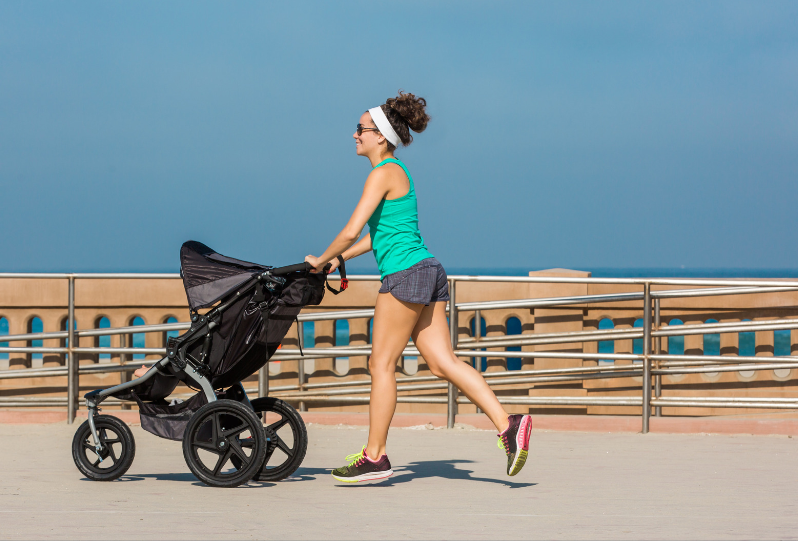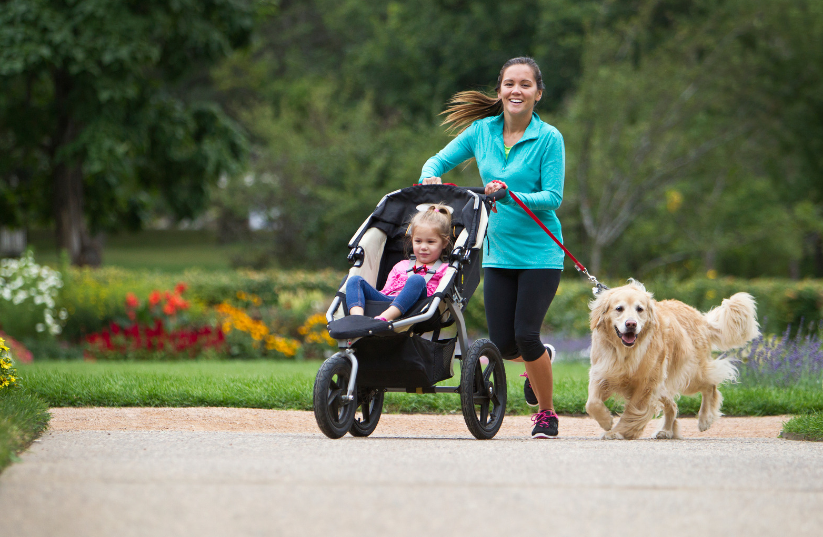
Pelvic Pain After Running Postpartum: Everything You Need To Know 2023

The time to return to running after baby can feel like an eternity. Especially for moms eager to feel like themselves again. This is true whether you were able to run during your pregnancy or not. Impatience causes many to return to running before they are ready and risk pelvic pain and urinary incontinence.
As a runner and a physical therapist, I know both the desire to get back out there as well as what is needed to be able to do so safely and effectively. That knowing doesn’t make the waiting any easier. It is recommended that new moms wait until at least 12 weeks postpartum before they resume or start running. They need to firsrt focus on building back pelvic floor and core strength.
After my 6 week clearance I began working on my pelvic floor, relieving tension and gradually building back strength. I impatiently waited until 14 weeks to resume running. It felt far too long. I was restricted from running most of this pregnancy due to placenta previa. Then needed to wait an additional 3 months! With intention and dedication I gradually rebuilt my strength and endurance. Happily I was able to complete a trail half marathon at 8 months postpartum.
I felt great! It had been at least 3 years since I run any races. I actually felt really good during it, well most of it. I was met with an unwelcome surprise around mile 12. The pelvic pain was around my pubic symphysis (that space in the front of your pelvis where the two halves meet.) It ached from mile 12 until a few hours after the race. With rest and ice I felt better and fortunately resumed running a few days later pain free.
So what is pelvic pain? Is it is normal postpartum? And what can you do about it? Let’s dive in!
What is Pelvic Pain?

Pelvic pain is a broad term that can mean any pain or discomfort in your lower abdomen and pelvic area. The pain can be from the muscles, ligaments, joints such as your pubic symphysis or sacroiliac joints (where your sacrum that flat bone before your tail bone meets with either side of your pelvic girdle.) Pain can also be along a c-section scar, at your bones such as your tail bone and internally in your vagina.
The pain can be sharp or dull and achey, constant or with specific activities.
Due to the broad and variable definitions used pelvic pain incidences is greatly variable from 5-50% and as high as 80% in runners.
What Causes Pelvic Pain After Running Postpartum?
Pelvic pain postpartum can be due to a variety of reasons. Increased ligament laxity and widening of the pelvis during pregnancy can be as cause. As can muscle tension or weakness. Pelvic organ prolapse can cause pain and so can scar tissue from c-section or vaginal tearing/ episiotomy.
Running can often cause or make pain symptoms worse due to the increased forces and stress that the pelvic floor and joints are under from loading, sheering, and increased intra-abdominal pressure. It is possible not to notice pelvic pain until during a run or after a run. This is more likely if you return to running before you are ready.
The 2019 postpartum exercise guidelines suggest 12 weeks as a minimum to return to higher impact activity such as running to decrease risk of poor outcomes such as pelvic pain, incontinence and prolapse. This allows time for the pelvis and organs to shift back into place after childbirth. It also allows time for healing of the muscles and ligaments. Of course these are just guidelines. The timeline may need to be adjusted if there were birth complications such as pubic symphysis diastases (separation) or tail bone dislocation. It is always a good idea to see a physical therapist prior to returning to running postpartum. It is essential if there were complications.
You are at greater risk for pelvic pain and other complications postpartum if you do not allow for adequate healing and rebuilding time.
Other than the physical healing you need to consider other factors before returning to running. If you are feeling exhausted postpartum you may want to wait on adding running into your routine. Running or performing higher level activities while feeling depleted you can place you at a higher risk of injury. Find out more about postpartum exhaustion here and address this first!

How Long Does Postpartum Pelvic Pain Last?
Typically postpartum pelvic pain resolves between 3-8 months and varies depending on cause and if treatment was sought out. It can last longer, especially if not addressed. According to The American Collage of Obstetrics and Gynecology pain that last longer than 6 months is considered chronic pain. When pain is chronic treatment and relief may take longer and usually needs a multidisciplinary approach.
Is It Normal For Your Pelvis To Hurt After Running?
While a painful pelvis might be common for postpartum runners it is not normal. I can not stress enough that what is common isn’t normal and what is normal isn’t always OK, especially postpartum. Pain during or after running is a sign that something is wrong and needs to be addressed. It is so important that we do not ignore these signs and chalk it up to “things are just different now that I am a mom.”
As you are resuming an activity that you have not performed in a while or are taking up for the first time, muscle soreness may happen. If this is the reason then discomfort should go away within 24-48 hours and should start decreasing with subsequent runs. Pelvic pain during or after running is often a sign of pelvic dysfunction and or a sign that you are returning to running either too soon or too quickly. Modifications need to be made.
Ok so now that we know it isn’t normal. What can be done?

What Can You Do About Pelvic Pain After Running Postpartum?
First, we want to try and avoid pain after running. We can do this by waiting the 12 weeks and then gradually returning to running. Start laying the ground work for running once you get cleared to exercise around 6 weeks. Start rebuilding your foundation first.
So let’s say you waited, you did the pre-work but you are still noticing pelvic pain after running. Now what?
✔️ Rest and Ice:
If you notice pelvic pain mid run, stop running and walk home. Do not try to push through the pain and finish out the run. Here is when you want to pull out your inflammatory skills with rest and ice. You can take an ice bath, cold shower or use an ice pack with towel barrier to the achey area for about 20 minutes. NSAIDs can also be affective but check with your MD first, especially if you are breastfeeding or if you are pregnant again. Also you do not want to use long term to cover up and ignore the pain!
Rest: you do not want to resume running while you still have pain. Remember if it is post-workout soreness that discomfort should go away within 24-48 hours. For me that seemed to be my problem. I likely amped up my milage a bit too soon. After 2 days of full rest I was able to resume lighter running pain free, and it stayed that way.
✔️ Change your shoes:
While I am generally a fan of neutral running shoes this isn’t always the best option. Overly pronated feet (or flat feet) can contribute to an exaggerated anterior pelvic tilt. This pelvic rotation is a normal adaptation to pregnancy and takes time to resolve back to your normal posture and alignment. However, weak arches and flat feet can further exaggerate the tilt and that could contribute to increased pelvic pain postpartum. We really are all connected!
You can try to get new shoes or add an insert for increased support. Not exactly sure have a professional fit you. This simple change might be what you need. Of course back up to the first tip, wait and rest until the pain resolves before trying out your new shoes.
✔️ Make an appointment with your physical therapist:
I know, I know this is the advice no one wants to hear ,especially a runner anxious to get back to it. If you have pelvic pain that doesn’t resolve with rest and ice quickly, and that reoccurs after taking time off and making small changes (such as new shoes) then it is time to make an appointment. Remember once pain is considered chronic it generally takes longer to resolve. Time is important here. Also while your runs maybe on hold for a bit as you work through your rehab program you deserve to really enjoy your runs again.
When To Consult Your Doctor
Physical therapy is a great first step (and often times the only step needed) if you have pelvic pain postpartum. Your physical therapist can do an evaluation and make an assessment of where the pain is coming from and properly refer you out if needed. Direct access allows for quicker initiation of treatment and is often more cost affective to start with. If you are in the US all 50 states have direct access (where you can go to your physical therapist without a referral from your physician) however each state has different guidelines and definition of access. In some states you need to notify your physician once a diagnosis is made. Other states you need to notify your physician within 30 days of treatment. So check with your local PT clinic to see what the rules are.
Many PT clinics will perform a return to running evaluation that you can do prior to even starting running. This is particularly a good idea if you have specific goals or timeline in mind or if you have had pelvic pain at rest or with other activities. If you are working with a certified postpartum trainer or coach prior to running and you notice new pain or pain that is not improving it is also a good idea to make an appointment with your physical therapist, the more people on your team the better!
Pain that you would describe as heaviness or dragging in your pelvic floor this can be a sign of prolapse. You will want to make an appointment with your pelvic floor physical therapist or physician. If pain is new and starts during or right after a run and limits your ability to bear weight make an appointment with you doctor. You will also want to make an appointment with your doctor if you are past 6 months and considered chronic. Multidisciplinary approach is best for treatment of chronic pain.

Conclusion: What to know about Pelvic Pain After Running Postpartum?
To recap: while common, pelvic pain after running is not normal.
The cause of pelvic pain and specifically after running can vary depending on where and what type of pain it is. Typically pelvic pain with postpartum running is due to a few reasons. Structural changes such as a wider pelvis, increased anterior tilt and increased ligament laxity and more rarely pubic symphysis diastase or tail bone dislocation or fractures. Pelvic floor dysfunction meaning weakness, increased tightness and tension and poor coordination of muscles in the pelvic floor can also be a common cause of pain.
These problems can largely be avoided when you allow enough time for healing and rebuilding postpartum. You should also consider other factors such as fatigue, breastfeeding and postpartum mood disorders which can all contribute to pelvic pain in postpartum runners.
You can take a few days of rest and ice and see if symptoms improve and also try changing shoes for better arch support to see if that fixes the pain. However if pain continues or worsens it is time to make that appointment with your physical therapist.
Want to see if you are ready to start running? Sign Up for "The Postpartum Revolution"
Thank you for sharing!
Struggling with postpartum pelvic pain, leaks, or discomfort? Download your FREE Postpartum Pelvic Recovery Guide and learn simple, expert-backed strategies to heal, strengthen, and feel like yourself again. Because your recovery matters—let’s take care down there!
